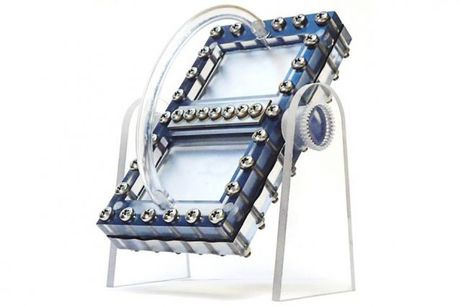New concept liquid battery developed at MIT

According to the MIT News office, researchers at MIT have demonstrated a new liquid battery design utilising a passive, gravity-fed arrangement similar to an old-fashioned hourglass. It is expected to offer advantages due to the system’s low cost and the simplicity of its design and operation, said the research team.
Liquid flow batteries — in which the positive and negative electrodes are each in liquid form and separated by a membrane — are not a new concept. The basic technology can use a variety of chemical formulations, including the same chemical compounds found in today’s lithium-ion batteries. In this case, key components are not solid slabs that remain in place for the life of the battery, but rather tiny particles that can be carried along in a liquid slurry. Increasing storage capacity simply requires bigger tanks to hold the slurry.
But all previous versions of liquid batteries have relied on complex systems of tanks, valves and pumps, adding to the cost and providing multiple opportunities for possible leaks and failures.
The new version, which substitutes a simple gravity feed for the pump system, eliminates that complexity. The rate of energy production can be adjusted simply by changing the angle of the device, thus speeding up or slowing down the rate of flow. The concept is described in a paper in the journal Energy and Environmental Science, co-authored by Kyocera Professor of Ceramics Yet-Ming Chiang, Pappalardo Professor of Mechanical Engineering Alexander Slocum, School of Engineering Professor of Teaching Innovation Gareth McKinley, and POSCO Professor of Materials Science and Engineering W Craig Carter, as well as postdoc Xinwei Chen, graduate student Brandon Hopkins and four others.
The original concept for flow batteries dates back to the 1970s, but the early versions used materials that had very low energy density — that is, they had a low capacity for storing energy in proportion to their weight. A major new step in the development of flow batteries came with the introduction of high-energy-density versions a few years ago, including one developed by members of this MIT team that used the same chemical compounds as conventional lithium-ion batteries. That version had many advantages but shared with other flow batteries the disadvantage of complexity in its plumbing systems.
The new version replaces all that plumbing with a simple, gravity-fed system. In principle, it functions like an old hourglass or egg timer, with particles flowing through a narrow opening from one tank to another. The flow can then be reversed by turning the device over. In this case, the overall shape looks more like a rectangular window frame, with a narrow slot at the place where two sashes would meet in the middle.
The work was supported by the Joint Center for Energy Storage Research, funded by the US Department of Energy.
Daikin Australia opens new Sydney factory
Daikin Australia has opened a new factory in Chipping Norton that aims to accelerate the...
AR3 to be first to process rare earths at ANSTO's new pilot facility
Australian Rare Earths has announced that it will be the first industry partner to access...
Defence Trailblazer funding manufacturing to help Defence and industry transition to clean energy
Defence Trailblazer has announced it is actively working with industry partners in funding a...











